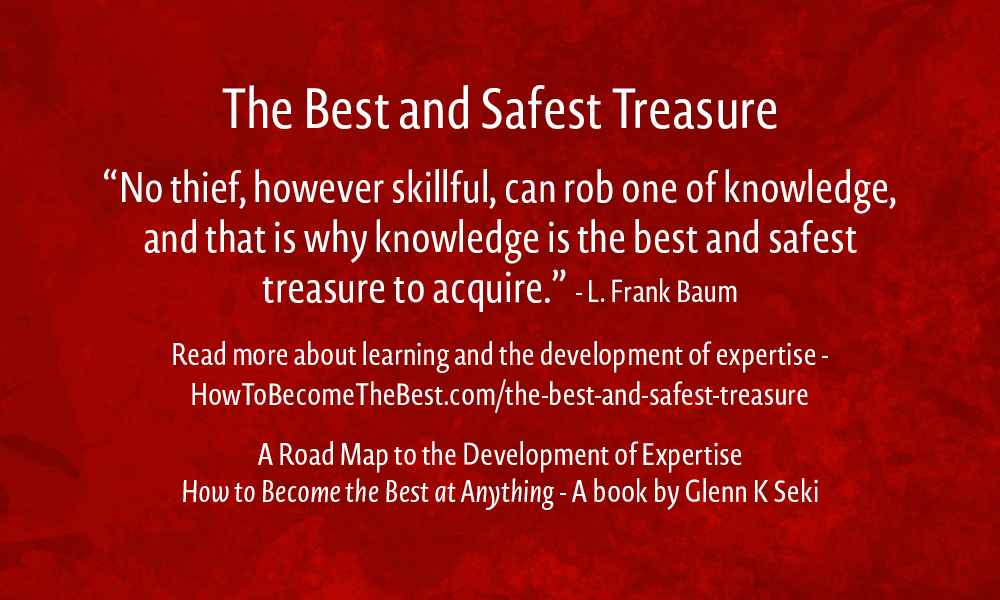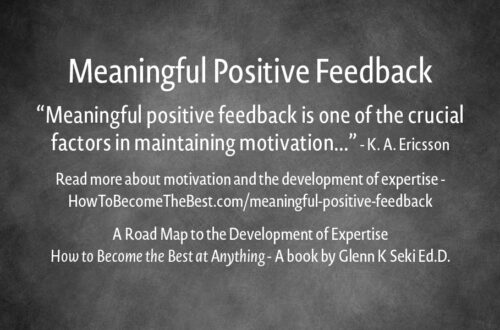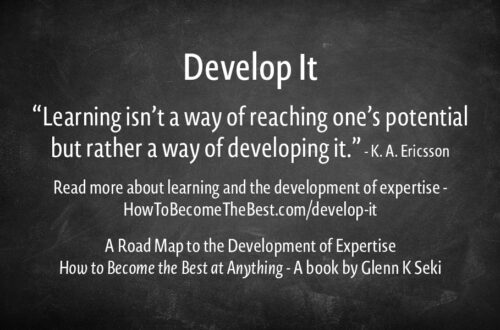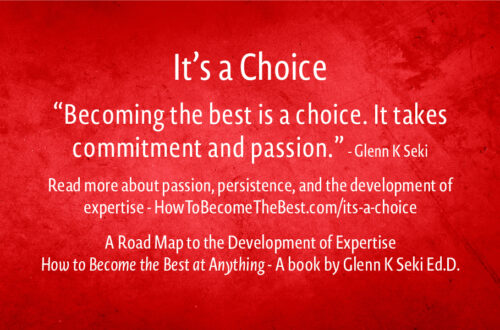“No thief, however skillful, can rob one of knowledge, and that is why knowledge is the best and safest treasure to acquire.” – L. Frank Baum
How you learn something…
An excerpt from How To Become The Best at Anything, Chapter 8, Deliberate Practice and Learning
Learning
“When you are trying to learn something new or you are teaching someone something new, it can be a very daunting task. It is difficult because learning something new is not easy, but it can be made easier if you understand how learning works.
Learning can be divided into four basic parts: concepts (definitions and examples), processes (how it works sequences), principles (cause and effect relationships), and productions (procedures/classifications).”
Concepts
“Here’s a common example of a concept: a chair. You can look at one and tell right away that it is a chair. A chair can have four legs, three legs, two legs, one leg, or no legs. A chair can have more than four legs. Your memory stores a definition and examples of chairs. You have learned the concept of a chair. To learn a new concept, you need a definition and examples of the concept.
Learning a concept sounds easy, and it is. However, you can run into problems when you have a lot of new concepts to learn in a short amount of time. In a typical high school biology class, a student will be given more vocabulary to learn (concepts) than in an average first-year high school foreign language class. I taught high school biology and many of my students struggled with the vocabulary. I would help them learn the new concepts by presenting them in different ways. They would first be exposed to the new concepts in their homework. Then in a lab, then in an exercise, and then in group work that would push them to apply the concepts in different ways and would show them how the concepts fit in with processes, principles, and productions.”
Processes
“A process is a “how it works sequence.” An example is how radar (radio detection and ranging) works. You have probably seen a radar device in movies and on television. Someone is looking at a screen and they are watching an airplane or missile in flight as it approaches.
A magnetron generates high-frequency radio waves, which are then sent to an antenna. The antenna acts as a transmitter, sending a narrow beam of radio waves through the air. The radio waves hit the airplane and are reflected back. The antenna picks up these reflected waves (usually the same antenna). The signal is then sent to a receiver. A computer in the receiver processes the reflected waves and renders them on the screen.
The sequence: antenna sends electromagnetic waves out – electromagnetic waves hit the airplane – electromagnetic waves reflect back – antenna receives the electromagnetic waves – computer draws them on a screen. Since you know the direction you sent out the electromagnetic waves, the speed of the electromagnetic waves and you know the time that has expired, you know the distance and direction to the plane.
Simple? Maybe not. You had to understand a number of concepts; electromagnetic waves, antenna, airplane, reflection, magnetron, etc. You probably didn’t know the concept, magnetron (a magnetron is a high-powered vacuum tube that works as a self-excited microwave oscillator), and this was a simplified version of how radar works. To learn a process, you need to have already learned the concepts in the process.
Remember Alma, the musical child prodigy? She has a process she has developed for when she gets “stuck” in a composition. In her mind, she goes to an imaginary country which she has invented, that is populated with many composers that write in their own style of emotion. She will ask them for advice and “quite often, they come up with very interesting things.” While I was unable to find her exact step-by-step process, she definitely seems to have a very elaborate process to help her when she gets “stuck.””
Principles
“Principles are cause and effect relationships. In other words, if this occurs then that happens. If that occurs then that doesn’t happen. I touch a hot pan on the stove, I burn my hand. I touch a cold pan on the stove, I don’t burn my hand. And I’m able to pick it up.
When I was working as a photographer for LMU and covering a basketball game, a fast break would occur, and the players would be running towards me. I already understood the process for this LMU’s basketball team’s fast break strategy (how their fast break plan works). If player #1 has the ball the team will drive for a layup or dunk. If player #2 has the ball that player will stop at the three-point line and put up a shot. If player #3 has the ball, the ball will be passed to players #1 or #2, and so on. I already had learned this team’s process and principle for a fast break. This allowed me to anticipate their actions and have the appropriate camera and lens combination, and which player to follow-focus (actively focusing on a moving object). I was able do this without consciously thinking about it because I had automated the procedure. Since I was manually focusing on their eyes, with a short telephoto lens (85mm f1.2), as they ran toward me on the basketball court, having the procedure automated allowed me to “get the shot.””
Productions
“Productions are procedures and classifications. This is the biggie! This is what you are trying to do to gain high levels of expertise. You want to automate procedures and classifications, so you don’t have to consciously think about them. Going back to the example of driving a car, you don’t have to consciously think about all the little things that it takes to drive a car in traffic because you have automated a set of procedures. Going back to the chair example, you can look at something and know it is a chair without consciously thinking about it because you have automated the classification of a chair. Going back to my photographing a basketball fast break example, I had all the concepts, processes, and principles I needed to get the shot and they had become automated so it was more like a reflex than a conscious action. I didn’t have to think about it, I just did it.”
“This is the goal of performing deliberate practice, the 10,000 hours, to automate procedures and classifications. To get there you need the concepts, processes, principles, and productions. Remember, you must automate the productions correctly. If you automate them incorrectly it will take a lot of work and time to un-automated it.
How do you practice? What do you practice? That depends on what domain and what production you are trying to automate. This is another reason why you need a coach. Your coach will help you with drills and practices to perform.”





